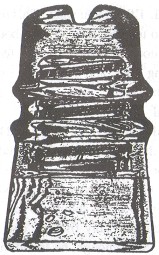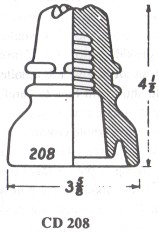Searching the A.T.&.T. Northern Transcontinental Toll Lead
by Mark Heitman
Reprinted from "Crown Jewels of the Wire", September 1992, page 21
Searching the A.T.&.T. Northern Transcontinental Toll Lead
The Stampede Pass Trips from /978 to 1983
Part C
(We pick up the story where we left off in the July, 1992 issue. p. 12)
On my last good hunt to the Stampede Pass area, former collector Eric Lenius
and I had decided to go into the Cabin Creek area. It was my fourth trip to this
area and Eric's first. We decided one of us would cover one side of the lead and
the other would get the opposite side. I told Eric if he saw any glass at all to
give me a holler and I would show him how to carefully remove it in case it was
lying at a weird angle or if a whole crossarm might be buried in the area. This
was Eric's first time using a potato rake also. We hunted for about half a mile
west of Cabin Creek and had just passed underneath a power lead that was
crossing the line in a diagonal angle from our path of travel. Eric was on the south side of the lead which was pretty flat,
and there wasn't too much underbrush as he was working under a nice thicket of
pine trees. Meanwhile, I was on the north side battling through some one to two
inch vine maples.

Just then, Eric let out a holler: "Hey, Mark! Come over
here, would you?" I replied, "got a hot one, Eric?" I went over
to his side and sure enough, about one eighth of a straight-up was poking through
the pine needles. I carefully removed the pine needles and dirt from around the
piece and discovered that it was attached to a buried, rotten crossarm. I worked
my way down the arm to the next pin to find another mint straight-up. I looked
at Eric and said, "you don't think it could be, do ya?" He somehow
knew I was talking about maybe finding a full rack of straight-ups on this
buried arm. He replied, "oh might be. I don't know." I told him,
"well, now you've watched me pull out two of them. Now it's time for you to
get into the fun. I just wish I knew where on the arm we're located. I'll tell you what. This thing is
eight to ten feet long. How about you going down one direction six feet and
working back, and I'll do the same on the other end."
"OK, you got
it," he replied. I dug about three inches and hit my end of the arm. At
this, I guessed I was four or five feet from the location where I had removed
the first two, so I told him to move about two feet closer and he'd probably
find the end of the arm. Sure enough, he found his end. We then each uncovered
two more straight-ups. We now had six of 'em with about two feet of arm left
that wasn't uncovered. I stopped and said, "well, you found the arm so I'm
gonna let you dig the last two pins, pal. Let's see if we get a full rack."
Sure enough, he dug out two more of the nice medium aqua straight-ups. In all,
we had eight nice medium aqua, mint straight-ups. What a day! To this day, that
is the only time I've ever been on a hunt and helped dig up a full rack of CD
141 's. Dang if beginner's luck didn't hit Eric just like it hit me.
That is
about all of the real good hunts that I've experienced on Stampede, but I'll
continue to look every time I get into the area. But, like I said earlier, the
glass is getting very, very hard to find. Any that is left is completely buried
and a lot has also been removed. As for now, I'll head this one on into the barn
until I get Chapter Two on the Idaho and Montana side of the line typed up.
Until then, I hope you have enjoyed my trips as much as I have.
I would like to thank my loving wife for all of her help in
writing and typing this chapter, and for the use of her oven and utensils,
although I don't think she was too impressed with my purple cracked pie (read on
for details). I would also like to thank the following people for their time and
their valuable information on Stampede Pass hunting that was included in this
chapter. Without their generous contributions, I wouldn't have been able to give
you a complete story on this segment of the A.T.& T. Northern
Transcontinental Toll Lead: Andy and Violet Brown, Win Trueblood, Dave Moffatt,
Dennis Moeller and Dick Hanson.
California CD 208 Specifications
I'm including the specs of my Cal 208's for those who didn't know that the
Cals come in two different lettered versions, and also for those who would like
to compare their Cals to mine.

1. California CD 208 - three-eighth' s inch high lettered version: Height
4-3/8 inches. Width 3-9/16 inches at the skirt base. Colors - Light smokey SCA, and
light smokey golden yellow. (Note - the base of my yellow ones measure 3-5/8
inches across the skirt.)
2. California CD 208 - half inch lettered version: Height 4-3/8 inches. Width
3- 9/16 inches at the skirt base. Color - Very light smokey SCA. (Note - the
height on mine is actually 13/32 of an inch.)
The most controversial California CD 208 is the yellow one. This particular
insulator has been under more scrutiny than any other insulator that I can think
of. I personally do not believe that the yellow Cals are fake. Below are the
reasons for my belief.
1. I have found one on Stampede myself and know about four others who have
also found them. I have known these people for ten years, and they are serious
insulator collectors.
2. I've placed my yellow Cal outside on sunny days to see what the sun's
effects have on its color. It's been outside 20-30 days over the past two years
since I found it. Results: no change in color whatsoever.
3. I recently found seven light smokey SCA Cal CD 162' s on an old railroad.
To prove the theory of the oven trick, I placed one in a cold oven and put the oven on 550 degrees., Broil. It was in there under the heat for about one
hour. After about ten minutes, the insulator did crack apart, but it did not
change color at all. The color was the same as when it was put in. I turned off
the heat and let it cool down. On this one, I caught #S%#@# from my wife as she
went to use the oven the next evening and discovered the Cal in one of her pie
pans. OOPS! I forgot to take out the pie. Needless to say, she wasn't too happy
about me experimenting with her oven and utensils. Oh, by the way, the Cal was
damaged when I started the experiment, as I could never do this to a nice Cal.
4. I have seen quite a few yellow Cals in just about every CD. at numerous
shows over the past ten years I've been in the hobby.
If anyone out there has any conclusive information that would positively
disprove my theories, I would be more than welcome to hear your theories. Please
feel free to write or call me, preferably between 6 p.m. and 9 p.m. PST (no
collect calls, please).
Mark Heitman
533 East Providence Street
Spokane, WA 99207
(509)483-4463
- - - - - - - - - - - -
Drawings of CD 141 and CD 208 are used with permission of N.R. Woodward, The
Glass Insulator in America, 1988 Report.
| 